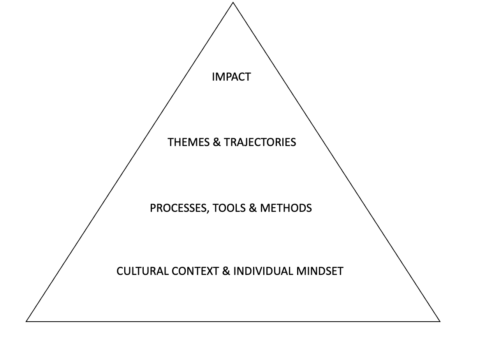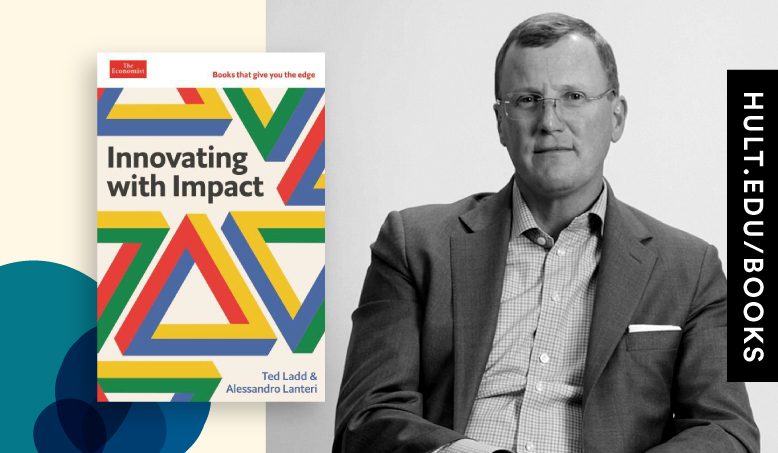Ted Ladd is Professor of Entrepreneurship & Innovation at Hult’s San Francisco campus. Here, he gives a glimpse into some of the tools, methods, and guidance you can find in his latest book—Innovating with Impact—co-written with Alessandro Lanteri.
Innovation everywhere
In 1815, the volcano Mount Tambora in Indonesia erupted, throwing enough ash into the atmosphere to block sunlight from reaching the earth. The event pushed much of the planet into a premature winter, precipitating a significant crop failure across Northern Europe in 1816. With limited fodder, farmers opted to feed cows, which could supply food, instead of horses, which were used primarily for transportation. People were forced to walk instead of ride, requiring more time and energy to travel.
With some simple tools and processes, everyone can contribute to innovation.
Two years later, Karl von Drais mounted a flat board between two wooden wheels a few feet apart. His device allowed a person to sit astride the board and plant their feet on the ground to run uphill or lift their feet to coast downhill. In front of a large crowd, he demonstrated that his laufmaschine (running machine) could go 7km (4.3 miles) in an hour. Ironically, this was considered too fast, causing this first incarnation of the bicycle to be outlawed in several cities for creating a hazard to pedestrians.
Karl von Drais demonstrated that anyone can innovate with impact. Innovation is not confined to a subset of preternaturally gifted people. With some simple tools and processes, everyone can contribute to innovation.
We think of innovation as a pyramid:


It must rest on solid foundations of culture and individual mindset. Company – and even national – characteristics of openness, agility, and ambidexterity provide a cultural context that promotes innovation. Personal traits like curiosity, objectivity, flexibility, adaptability, and grit all enhance innovativeness.
People who embrace the right attitudes are not guaranteed to be successful in innovation, but people who show none of these characteristics are probably doomed to an uninnovative future. These foundations are empirically more likely to lead to the adoption of a process for innovation, which is then more likely to generate an innovative idea.
At the next level of the innovation pyramid are processes, tools, and methods that intentionally promote new opportunities. These encourage new ideas, identify sources of authentic value, refine existing products and services, or develop new ones that can deliver value. Such processes and techniques transform ideation from a freak event into a serious game of probabilities.
Curiosity, objectivity, flexibility, adaptability, and grit all enhance innovativeness.
Many contemporary efforts to innovate converge towards some common themes and trajectories. In recent years, companies have found huge success by creating multi-sided platforms, by experimenting with novel pricing that descends all the way to “free”, by collecting and analyzing large data sets with artificial intelligence, and by emphasizing innovations that benefit not just company profits but also communities and societies. These examples can provide inspirational cases for other innovators to amend and adapt to new markets.
At the summit of the pyramid sits impact, the ultimate purpose of successful innovation. Innovation is good for everyone. It improves productivity and reduces costs. This means we can use our scarce resources to do more, help more users meet more of their needs, and so earn more resources that we can invest into further innovation.
Innovation makes organizations more competitive – that is, they can seize a bigger share of the pie than their competitors who lag behind. But it is not a zero-sum game. We defined innovation as creating value. This means it enlarges the pie to the benefit of many stakeholders. This is the impact an innovator can expect.
Innovation is a team activity.
Get going. Successful innovation is a hands-on exercise. You cannot innovate by thinking or running meetings. Impactful innovators have a formal innovation program or plan and the longer it has been running, the more successful it is. The advice here is similar to the advice for those who want to improve their health. The best time to start training was ten years ago. The next best time? Right now.
Innovation is a team activity. It requires a diversity of perspectives and the support of many partners. Impactful innovators bring onboard C-suite leaders, customers, peers, even competitors if necessary.
Keep going. Everyone is excited on the first day of class. It’s only when the first assignments come in that stress kicks in. Innovation initiatives are accompanied by announcements and fanfare. But innovation happens only after overcoming setbacks. By its very nature, it entails failure. Innovation requires doing new things, doing new things requires learning, and learning entails mistakes. Among entrepreneurial communities, fail fast is the mantra. Not so much because entrepreneurs enjoy failure, but because they understand that mistakes are essential to learning and that failure is not the opposite of success, but its precondition. There are no quick wins in innovation.
Let go. Innovation is most effective when it is let loose. Micro-management and over-management are the greatest threats to impactful innovation. Innovation is a learning journey. It occurs at its best when it is allowed to progress with a clear goal and a clear process, but with flexible margins to deviate.
Almost exactly 200 years after Karl von Drais invented the laufmaschine out of a straight wooden board between two wheels in Germany, Kyle Doerksen created a device from a straight board and a single wheel in Santa Cruz, California. Using a battery and sensors, the Onewheel is a “self-balancing” transportation vehicle. Someone standing on the board only needs to lean forward for the device to start moving forward. The rider leans back to slow down and leans back more to move in reverse. The device itself learns the rider’s habits to customize and improve its performance through data analysis.
Innovations cascade and thrive in environments that embrace mindsets, culture, processes, and trajectories so that everyone can innovate with impact.
For more practical advice on unlocking the power of innovation, Ted’s latest book—Innovating with Impact—is available to purchase now.


About the authors
Ted Ladd teaches innovation at Harvard, Stanford, and Hult. He has participated in six different start-ups in Silicon Valley. The most recent was acquired by Google as the foundation for its Wear OS smartwatch.
Alessandro Lanteri is Professor of Strategy and Innovation at ESCP Business School and teaches executive education programs for the University of Oxford’s Saïd Business School and London Business School. He works with multinationals, governments, international organizations, startups, and family businesses across five continents.


